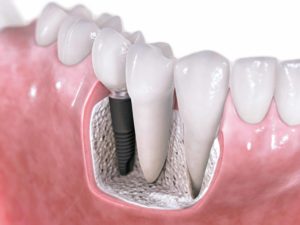Any person who needs to replace a missing tooth can benefit from dental implants. A dental implant is a small post which acts as a root for tooth replacement. It is made of titanium, a precious metal which has been proven to be particularly bio compatible. The body accepts it as if it were part of it and titanium is used in many medical situations. Its high strength and resistance make it invaluable in its use in dental implants.
Alternative to dental implants include bridge and denture. A bridge is a good option for missing tooth replacement if the missing tooth is in a less visible part of your mouth. It’s relatively cost-effective, but it is not without drawbacks. The neighbouring teeth can require treatment to make them suitable to support the bridge, which means removing some of the natural tooth structure or even crowning them.
A partial denture is a cost-effective option, but we find that many patients prefer not to have a denture for just one tooth. Dentures can feel bulky, be difficult to tolerate, and can make it difficult to eat or speak properly. Initial tooth replacement cost of dental implant can be relatively high when compared to dentures. However, according to British Health Foundation is now regarded as more cost effective options in the longer run.
Dental implants can improve confidence and appearance. They allow people who have missing teeth to be able to smile, speak, and chew well and comfortably. Implants can restore the natural smile creating increased reassurance and spontaneity of expression.

How will the implant be placed?
First, the implant, which looks like a screw or cylinder, is placed into your jaw. Over the next two to six months, the implant and the bone can bond to form an anchor for your artificial tooth. A temporary tooth replacement option can be worn over the implant site during this time.
Often, a second step of the procedure is necessary to uncover the implant and attach an extension. This temporary healing cap completes the foundation on which your new tooth will be placed. Your gums can heal for a couple of weeks following this procedure.
Some implant systems (one-stage) do not require this second step. These systems use an implant which already has the extension piece attached. Your periodontist will advise you on which method is best for you.
Finally, a replacement tooth called a crown will be created for you by your dentist and attached to a small metal post called an abutment. After a short time, you will experience restored confidence in your smile and your ability to chew and speak. Dental implants are so natural-looking and feeling you may forget you ever lost a tooth.
Every case is different, and some steps can be combined when conditions permit. Your dental professional will work with you to determine the best treatment plan.

